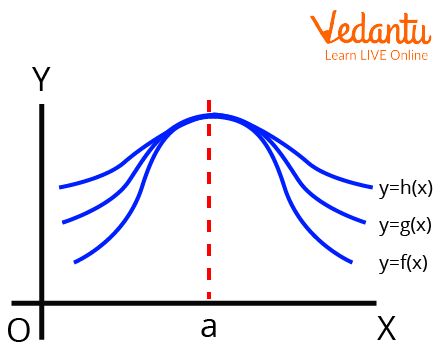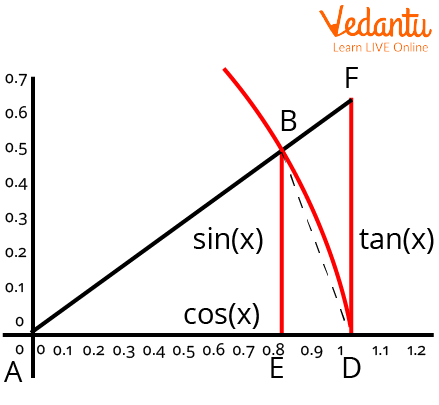




Step-by-Step Guide: How to Use the Sandwich Theorem in Limits
We may have encountered several theorems in calculus, most notably when calculating the challenging limits and derivatives of functions. Although there are several theorems and formulas for determining the limits of different kinds of functions, we always look for the simplest technique to solve them to obtain the answer quickly. One such use to resolve limit problems is the sandwich theorem.
In calculus, especially mathematical analysis, the Sandwich theorem is typically applied. This theorem is likely used to determine a function's limit by comparing it to two other functions whose limits are known or can be calculated with certainty. This article explains the sandwich theorem and how to apply it to various calculus problems.
History of Carl Friedrich Gauss
To compute π, the mathematicians Archimedes and Eudoxus utilised it for the first time geometrically. Carl Friedrich Gauss then expressed it in more contemporary terms.

Carl Friedrich Gauss (30 April 1777 – 23 February 1855)
What is the Sandwich Theorem in Limits?
Let f, g, and h be real functions such that for any x in the shared definition domain, f(x), g(x), and h(x) occurs. If "a" is a real number, then
$\begin{array}{l}\mathop {{\rm{\;}}\lim }\limits_{x \to a} f\left( x \right)\;\; = \;\mathop {lim}\limits_{x \to a} h\left( x \right)\; = \;t\\{\rm{then}}\;\mathop {\lim }\limits_{x \to a} g\left( x \right)\; = \;t\end{array}$

Sandwich Theorem
Sandwich Theorem Proof
Let's examine the geometric proof for the aforementioned claim using a trigonometric inequality.
$Cosx < \dfrac{Sinx}{x} < 1$

Proof of The Sandwich Theorem
We can see the triangles, ΔABE, ΔADF, ΔADB, and sector ADB in the above diagram.
\[; Area \; of (\triangle ABD)< \; Area \; of \; sector \; ADB< \; Area \; of (\triangle ADF)\\ \Rightarrow \dfrac{1}{2}AD\cdot EB < \dfrac{x}{ 2\pi}\pi \cdot AD^{2}< \dfrac{1}{2}AD\cdot DF\]
By eliminating the common terms from all sides,
${\rm{EB}} < x.AD < {\rm{ DF}}$
Since angle A = angle X,
EB = AB Sin(x) (from $\triangle ABE$),
and ${\mathop{\rm Sin}\nolimits} A = \dfrac{{EB}}{{AB}}$.
$DF = AD\tan x$ because $\tan x = \dfrac{{DF}}{{AD}}$.
However, $tan {A} = \dfrac{Sin{x}}{Cos{x}}$.
Consequently,
$AD\cdot Sin{x} < x\cdot AD<AD\cdot \dfrac{Sin{x}}{Cos{x}} \\ \Rightarrow 1< \dfrac{x}{Sin{x}}<\dfrac{1}{Cos{x}}$
By taking reciprocals,
$\cos x\; <\dfrac{Sin{x}}{x} < 1$
Hence Proved.
We can simply demonstrate some other trigonometric identities using the aforementioned theory, including
$\displaystyle \lim_{ x \to 0}\dfrac {Sin{x}}{x} = 1 \\ \displaystyle \lim_{ x \to 0}\dfrac {1- Cos{x}}{x} = 0$
Applications of Sandwich Theorem
To determine the limits of specific trigonometric functions, utilise the Sandwich rule.
It can be applied to link certain sequences between other known sequences that also converge to the same place to demonstrate the convergence of those sequences.
Sandwich Theorem Examples
1. Evaluate $\displaystyle \lim_{ x\to 0 } \dfrac {tan{x}}{x}$.
Ans: Using the trigonometric identity,
$\begin{array}{l}\tan x\; = \dfrac{{\;\sin x}}{{\cos x}}\\\therefore \mathop {\lim }\limits_{x \to 0} \;\dfrac{{\sin x}}{{x\cos x}}\; = \;\mathop {\lim }\limits_{x \to 0} \;\dfrac{{\sin x}}{x}\cdot\mathop {\lim }\limits_{x \to 0} \;\dfrac{1}{{\cos x}}\end{array}$
And from the Sandwich theorem, we know
$\displaystyle \lim_{ x\to 0 } \dfrac {Sin{x}}{x} = 1$
$ \displaystyle \lim_{ x\to 0 } \dfrac {1}{Cos{x}} = 1 $
Therefore,
$1\cdot1\; = \;1$
2. Prove that $\mathop {\lim }\limits_{x \to 0} \sin x\; = \;0$.
Ans: As known,
$-x \leq Sinx \leq x$ for all $x \geq 0$
$\displaystyle \lim_{x \to 0}(-x) = 0 $ and $ \displaystyle \lim_{x \to 0}(x) = 0$
By Sandwich Theorem,
$\mathop {\lim }\limits_{x \to 0} \left( {Sinx} \right)\; = \;0$
3. Evaluate $\mathop {\lim }\limits_{x \to 0} x\left[ {\left[ {\dfrac{1}{x}} \right] + \left[ {\dfrac{2}{x}} \right] + ...... + \left[ {\dfrac{{15}}{x}} \right]} \right]$.
Ans: Expand the given term as follows:
$\dfrac{1}{x} - 1\leq \left [ \dfrac{1}{x} \right ]\leq \dfrac{1}{x}+1\\ \dfrac{2}{x} - 1\leq \left [ \dfrac{2}{x} \right ]\leq \dfrac{2}{x}+1 \\ \dfrac{15}{x} - 1\leq \left [ \dfrac{15}{x} \right ]\leq \dfrac{15}{x}+1$
Adding them all up, we get
$\dfrac{120}{x} -15 \leq \left [ \dfrac{1}{x} \right ]+\left [ \dfrac{2}{x} \right ]+\cdots +\left [ \dfrac{15}{x} \right ]\leq \dfrac{120}{x} +15\\ \Rightarrow 120 -15x \leq x\left [ \left [ \dfrac{1}{x} \right ]+\left [ \dfrac{2}{x} \right ]+\cdots +\left [ \dfrac{15}{x} \right ] \right]\leq 120+15x \\ \Rightarrow \displaystyle \lim_{x \to 0}(120 -15x) \leq x\left [ \left [ \dfrac{1}{x} \right ]+\left [ \dfrac{2}{x} \right ]+\cdots +\left [ \dfrac{15}{x} \right ] \right]\leq \displaystyle \lim_{x \to 0}(120+15x)\\ 120 \leq x\left [ \left [ \dfrac{1}{x} \right ]+\left [ \dfrac{2}{x} \right ]+\cdots +\left [ \dfrac{15}{x} \right ] \right]\leq 120$
This gives
$\displaystyle \lim_{x \to 0}x\left [ \left [ \dfrac{1}{x} \right ] +\left [ \dfrac{2}{x} \right ]+ \cdots +\left [ \dfrac{15}{x} \right ]\right ] = 120$
Important Points to Remember
This theorem is probably utilised to establish the limit of the function in question.
All the functions considered must be real.
Important Formula to Remember
According to the Sandwich theorem,
If $\begin{array}{l}\mathop {{\rm{\;}}\lim }\limits_{x \to a} f\left( x \right)\;\; = \;\mathop {lim}\limits_{x \to a} h\left( x \right)\; = \;t\\{\rm{then}}\;\mathop {\lim }\limits_{x \to a} g\left( x \right)\; = \;t\end{array}$
Conclusion
In this article, we have thoroughly discussed the Sandwich theorem and its proof. From the discussion above about the Sandwich theorem, we can conclude that the Sandwich theorem allows us to determine the limit of a single function by using the limits of the two other functions that is "sandwiched" between these two. When a function gets complex or intricate, or perhaps when we are unable to identify the limit using other techniques, we apply the Sandwich theorem to determine its limit.
FAQs on Sandwich Theorem Explained for Students
1. What is the Sandwich Theorem in simple terms?
The Sandwich Theorem, also known as the Squeeze Theorem, helps us find the limit of a function that is difficult to calculate directly. The main idea is that if a function is 'sandwiched' or trapped between two other functions, and both of those outer functions approach the same limit at a specific point, then the function in the middle must also approach that very same limit.
2. Are the Squeeze Theorem and the Sandwich Theorem different?
No, they are not different. Squeeze Theorem, Sandwich Theorem, and sometimes the Pinching Theorem are all different names for the exact same mathematical principle used in calculus to evaluate limits.
3. What conditions must be met to use the Sandwich Theorem?
To apply the Sandwich Theorem to find the limit of a function g(x) as x approaches a point 'c', you need to satisfy three conditions:
- You must have two other functions, say f(x) and h(x), such that f(x) ≤ g(x) ≤ h(x) for all x in an open interval containing 'c'.
- The limit of the lower function, f(x), as x approaches 'c' must exist.
- The limit of the upper function, h(x), as x approaches 'c' must exist and be equal to the limit of f(x).
4. Why is this concept called the 'Sandwich' Theorem?
The name is an analogy to help understand the concept. Think of the two outer functions as two slices of bread and the middle function as the filling. If you squeeze both slices of bread together towards a single point (the limit), the filling trapped between them is forced to go to that same point. It has no other place to go.
5. What is the most common example of the Sandwich Theorem in the Class 11 syllabus?
The most famous and important application of the Sandwich Theorem in the CBSE Class 11 syllabus is to prove the fundamental trigonometric limit: lim (sin x)/x = 1 as x → 0. This proof is crucial as it forms the basis for finding the derivatives of trigonometric functions.
6. Can the Sandwich Theorem be applied to sequences as well as functions?
Yes, absolutely. The same logic applies to sequences. If you have a sequence that is always between the terms of two other sequences, and both of those outer sequences converge to the same limit L, then the sequence in the middle is also guaranteed to converge to L.
7. Can I use the theorem if I only know that my function is smaller than another one?
No, you cannot. The power of the theorem comes from having the function squeezed from both sides. Just knowing that one function is smaller than another (e.g., g(x) ≤ h(x)) is not enough to determine its limit. You need both a lower bound and an upper bound that are approaching the same value.
























